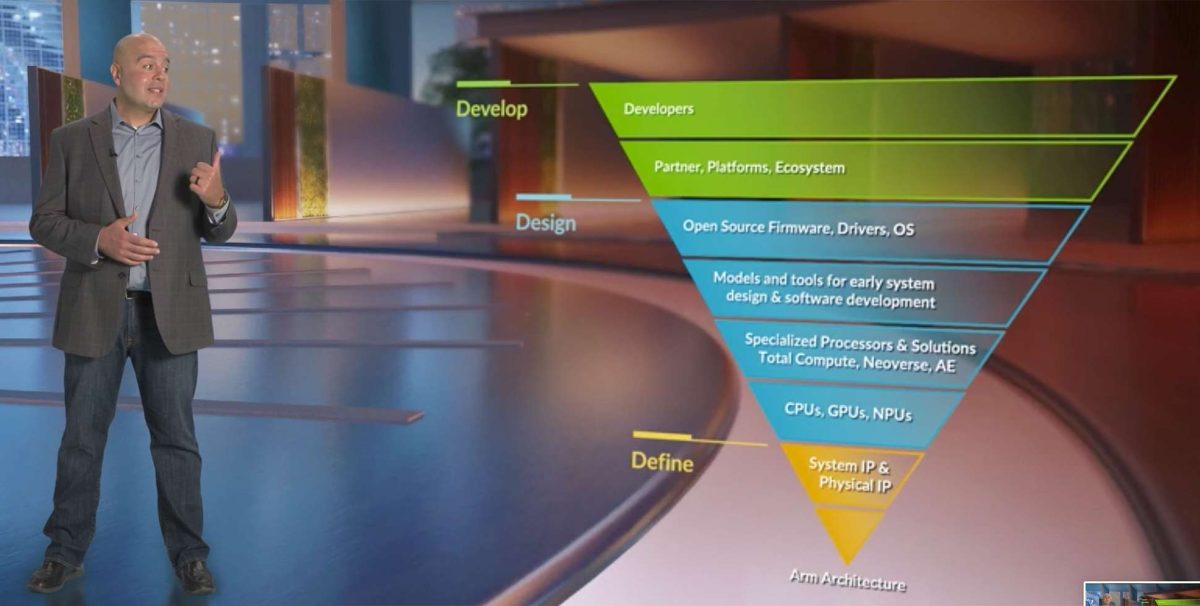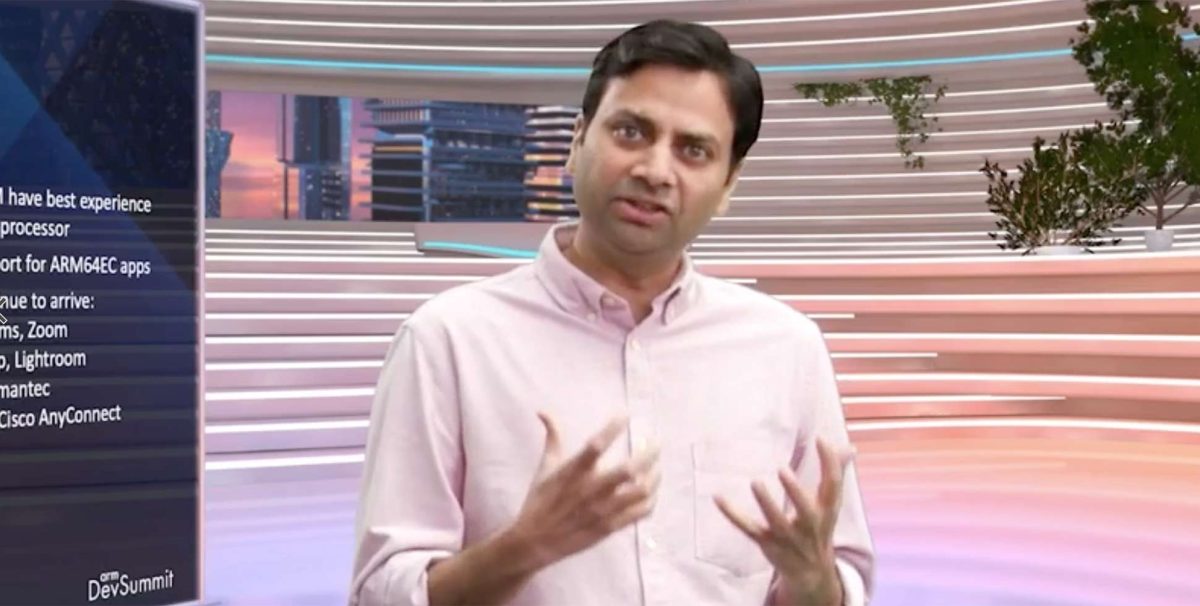Arm DevSummit 2021: Day 1 Keynotes

The Arm Blueprint team is attending Arm DevSummit 2021, a three-day virtual event that provides a place for Arm software and hardware developers to learn, connect and develop together.
Over the next three days we’ll be bringing you key highlights and takeaways from Arm DevSummit 2021 keynotes by Arm executives and our partners.
Performance and Purpose: The New Compute Imperative
Simon Segars, CEO, Arm

In his opening keynote, Simon Segars reinforces the role of Arm DevSummit in bringing Arm’s hardware and software developer ecosystems together. Today, says Segars, the need to ensure hardware and software are co-developed is as critical as ever. Hardware technology improves quickly and with it comes new opportunities and challenges, requiring increasingly complex languages, libraries, and frameworks.
Segars goes on to recap some of Arm’s announcements over the past year. Armv9, the latest version of the Arm architecture launched in March, was engineered to be the foundation for the next decade of compute. It delivers the power of specialized processing with the design freedom, accessibility, and economies of scale that come from the world’s most pervasive computing platform – now, and in the years ahead.
Citing statistics such as nearly half of all US hospitals have had to disconnect their networks at some point in the past six months due to escalating attacks, Segars talks about the vital role of Confidential Compute [What Is Confidential Computing? Here’s A Great Example], an industry-wide solution that goes beyond just encrypting stored data, and how it’s built into Armv9.
He goes on to discuss 5G, the new Arm Total Solutions for IoT and the need to reduce power consumption by decarbonizing compute and driving efficiencies in Arm technology by increasing performance per watt.
Finally, Segars explains how all of this lays a foundation for the most important technology of the next 50 years: artificial intelligence (AI), from self-driving cars to accelerating the discovery of life-saving medicine. Arm’s efforts to enable AI started many years ago and Segars anticipates that this technology will enhance the entire spectrum of computing.
Simon Segars: Performance and Purpose: The New Compute Imperative
Watch this session now at Arm DevSummit 2021. Registration required.
Designing with Systems in Mind
Mohamed Awad, Vice President, IoT & Embedded, Arm

Mohamed Awad opens his keynote with a nod to the work from our partners in shipping 200 billion Arm chips. We’ve learned a lot since Arm’s humble beginnings 30 years ago, he says, about how a systems approach can be transformational.
“This is what we mean by a systems approach,” he says, gesturing to the diagram above and explaining each element.
Awad mentions the Memory Tagging Extension (MTE) as a great example of how Arm worked with its partners to define new features for mobile devices. MTE was co-developed with Google to significantly improve security for Android developers. Taking a systems approach means the software to enable MTE will be ready ahead of the new Armv9-based chips arriving at the end of this year.
We’re now applying this solutions approach to our infrastructure line of business, says Awad. Through deep collaboration with our partners to understand the end-to-end needs of cloud and server users, we launched initiatives such as Arm ServerReady, now Arm SystemReady, which provides designs on key aspects of the underlying platform for diverse edge and endpoint devices.
Now, says Awad, it’s time to 10x the Internet of things (IoT)!
We need to be honest about how hard it is to build IoT system today, says Awad. There is embedded software, Cloud services, hardware design, connectivity, application development, machine learning (ML) and of course, security. All of these systems are complex and often massively fragmented.
The solution is a systems approach – and the result is Total Solutions for IoT, launched yesterday. But as an extension of this, Arm is also launching Arm Virtual Hardware Targets.
Virtual hardware massively simplifies embedded software development, says Awad. Focus can shift away from building boards and configuring wires and jumpers and move to delivering great products and services, the same way development does in other markets.
With virtual hardware, Awad says embedded developers can adopt more modern methodologies, like continuous integration / continuous delivery (CI/CD) without having to build and maintain hardware farms.
A game-changer that alone could 10x the IoT.
The first configurations of Arm Total Solutions for IoT are available today, says Awad. They are built around the Corstone-300 subsystem that features our Cortex-M55 and Ethos-U55 processors.
On the hardware side, the IP is available through Arm Flexible Access – and on the software side, you can freely access the complete Total Solutions Software Development Kits on Arm’s Github.
Mohamed Awad: Designing with Systems in Mind
Watch this session now at Arm DevSummit 2021. Registration required.
Developing for the next generation of Windows on Arm
Hari Pulapaka, Partner Group Program Manager, Microsoft

Our first partner keynote at Arm DevSummit opens with Hari Pulapaka, who has been part of the Windows on Arm team at Microsoft since its inception.
“If there’s one thing we’ve learned in this past year, it’s that the world is changing” says Pulapaka. “There are new live scenarios that didn’t even exist a year ago.”
This has accelerated our customers’ needs to digitally transform their business, says Pulapaka, and the industry is now going through a fundamental transformation as it pivots towards a focus on the intelligent edge and intelligent cloud.
5G, AI and IoT edge devices will be the key technologies that drive this transformation and Microsoft has been key in the development of all 3. But with Windows 11, 5G and AI are being put front and center in PCs, says Pulapaka. And when it comes to multi-day battery life, instant-on power management and 5G connectivity, it’s Windows on Arm notebooks that have the edge.
By enabling Windows to leverage key capabilities of the Arm architecture such as big.LITTLE and low-power standby, Windows on Arm PCs can deliver more than 24 hours of local video playback, says Pulapaka. That’s a lot of (offline) binge-watching. In the Microsoft Surface Pro X, Microsoft has also invested heavily in the AI features built into the processor.
Pulapaka shares a slide showing how many Arm-powered PCs are now available from the likes of HP, Samsung, Lenovo and Acer, the majority in the laptop form factor and ranging from premium through mainstream to entry-level.
“Your apps are the reason customers use a Windows PC”, he says. Windows 11 makes it even easier to port apps to Arm via targets including ARM64EC and ARM64X, new application binary interfaces (ABI) for Windows 11 on Arm that run with native speed and are interoperable with x64.
Developing for the next generation of Windows on Arm
Watch this session now at Arm DevSummit 2021. Registration required.
Any re-use permitted for informational and non-commercial or personal use only.











